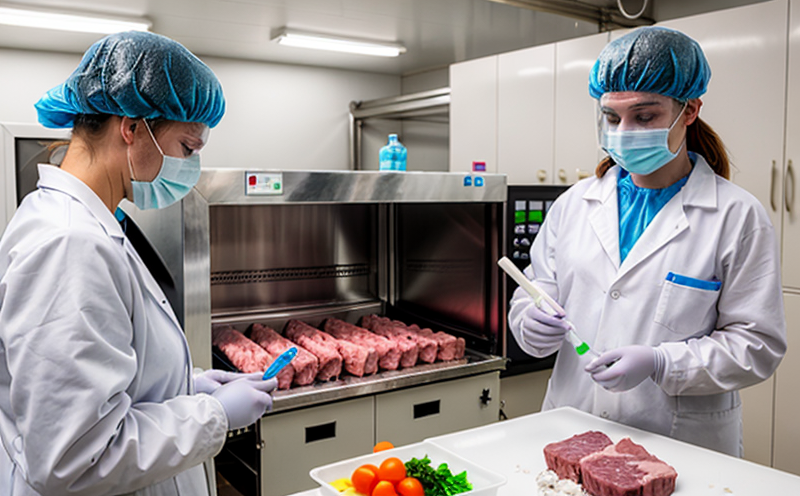USDA FSIS Total Plate Count in Meat and Dairy Plants
The USDA Food Safety and Inspection Service (FSIS) Total Plate Count test is a critical measure used to monitor the sanitary conditions of meat and dairy processing environments. This test quantifies the total number of viable bacterial colonies that can be isolated from a specific sample, providing insights into the microbial load present in food products. The results are reported as Colony-Forming Units (CFUs) per gram or per square centimeter.
The Total Plate Count is not only an indicator of cleanliness but also serves as a key performance metric for ensuring that meat and dairy plants meet stringent hygiene standards set by FSIS. Compliance with these regulations is mandatory to maintain the safety and quality of food products, thereby protecting public health from potential microbial contamination risks.
For dairy plants, the Total Plate Count test ensures that milk and its by-products are free from harmful bacteria that could compromise product integrity or lead to spoilage. In meat processing facilities, this test helps identify any cross-contamination between raw meats and ready-to-eat products, which is a significant concern for food safety.
The methodology involves taking samples from various points within the facility, including surfaces, equipment, and air, then inoculating these onto selective media plates designed to favor bacterial growth. After incubation at specific temperatures over several days, the colonies are counted manually or using automated colony counters.
This service is essential for maintaining a clean production environment, which directly impacts the safety and quality of food products. By adhering to FSIS guidelines, meat and dairy plants can ensure they meet regulatory requirements and maintain consumer trust in their brands.
Understanding the Total Plate Count test requires familiarity with its significance in ensuring food safety. This test plays a vital role in preventing contamination that could lead to product recalls or health issues. The results of this test are used by quality managers, compliance officers, R&D engineers, and procurement teams to make informed decisions regarding facility hygiene practices and product quality.
Compliance with FSIS regulations is non-negotiable for meat and dairy plants, as it ensures that the food products meet the highest standards of safety and quality. Non-compliance can result in significant penalties, including fines and closure orders, which underscores the importance of this testing service.
Why It Matters
The USDA FSIS Total Plate Count test is crucial for several reasons:
- Food Safety Compliance: Adhering to FSIS guidelines helps meat and dairy plants avoid penalties and maintain their license to operate.
- Consumer Trust: Ensuring the safety and quality of food products enhances consumer confidence in brands, which is vital for long-term success.
- Risk Mitigation: By identifying potential sources of contamination early on, facilities can take proactive measures to prevent product recalls or health issues.
The Total Plate Count test provides a quantitative measure that helps facilities understand their current hygiene levels and areas needing improvement. This data-driven approach allows for targeted interventions and continuous improvement in facility cleanliness and sanitation practices.
Additionally, the results of this test are often shared with regulatory bodies like FSIS as part of routine inspections or audits. Consistent compliance with standards can lead to favorable outcomes during these evaluations, ensuring that facilities remain up-to-date with best practices in food safety.
Why Choose This Test
- Comprehensive Coverage: The Total Plate Count test provides a comprehensive overview of the microbial load present in various parts of the facility, offering detailed insights into potential contamination sources.
- Regulatory Compliance: By adhering to FSIS guidelines, facilities ensure they meet all necessary regulatory requirements and avoid penalties.
- Data-Driven Decisions: The quantitative nature of this test allows for informed decision-making regarding facility hygiene practices and product quality control measures.
The Total Plate Count test is a cornerstone of food safety in meat and dairy plants. Its ability to provide detailed, actionable data makes it an indispensable tool for maintaining the highest standards of cleanliness and sanitation within these facilities.
Moreover, this test offers peace of mind for quality managers, compliance officers, R&D engineers, and procurement teams by ensuring that their operations meet stringent hygiene standards set by FSIS. This not only protects public health but also enhances brand reputation through consistent adherence to food safety protocols.
Quality and Reliability Assurance
The reliability of the Total Plate Count test is ensured through strict adherence to international standards such as ISO 4831, which specifies procedures for enumeration of microorganisms in foods. These standards provide a robust framework that guarantees accurate and consistent results across different laboratories.
Quality assurance measures include regular calibration of equipment used during sample preparation and analysis, as well as ongoing training for laboratory personnel to ensure they are up-to-date with the latest testing techniques. This commitment to excellence ensures that every test conducted meets the highest standards of accuracy and precision.
- Precision: The use of advanced microbiological media and incubation conditions allows for precise enumeration of microorganisms, even in complex samples.
- Reproducibility: Standard operating procedures (SOPs) ensure that each test is conducted under consistent conditions, leading to reliable results across multiple samples.
The Total Plate Count test plays a vital role in the overall quality assurance process for meat and dairy plants. By providing accurate and reproducible data, this service helps facilities maintain their commitment to food safety and quality.
Regular audits and internal reviews further reinforce the reliability of these tests, ensuring that any discrepancies are addressed promptly. This continuous improvement approach ensures that facilities remain at the forefront of best practices in food safety and hygiene.





